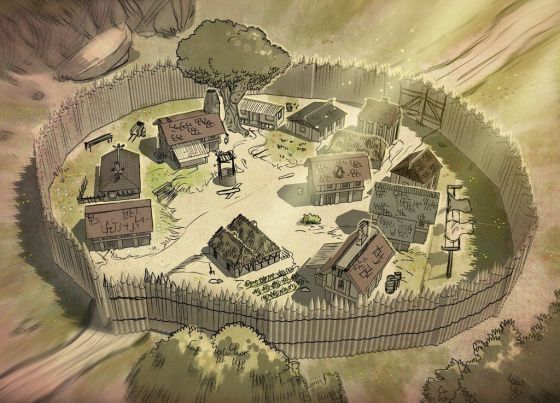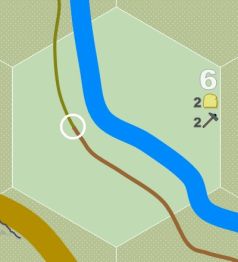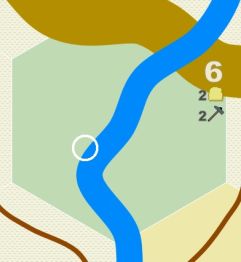Difference between revisions of "Bailey Hamlet"
Tao alexis (talk | contribs) |
Tao alexis (talk | contribs) |
||
| Line 57: | Line 57: | ||
</gallery> | </gallery> | ||
<br> | <br> | ||
| + | |||
| + | == Generator == | ||
| + | A generator for determining a bailey hamlet's population and surrounding hex can be found here: [https://docs.google.com/spreadsheets/d/1d29Gd8Z81_-3jAPvCWmmtig_IQWt9KWk/edit#gid=1948672628&rtpof=true&sd=true generator]. | ||
| + | |||
| + | See also,<br> | ||
| + | [[Bread (symbol)]]<br> | ||
| + | [[Coin (symbol)]]<br> | ||
| + | [[Hammer (symbol)]]<br> | ||
| + | [[The Adventure]] | ||
Revision as of 06:00, 5 September 2023
Bailey hamlets consist of a tightly-knit gathering of dwellings and buildings protected by an outer fortification, or bailey, which surrounds the hamlet's inner yard. It's not uncommon for the hovels of less important residents to be located outside the bailey's palisade and defensive ditch.
Such hamlets are always supported by a significant river, with individual farms and communal holdings besides. While they share many characteristics of communal hamlets, a sizable number of persons acting as artisans and skilled labourers accounts for a class of persons that are distinctly non-agrarian, and therefore apart from the communal ideal.
Tradition and religion are highly respected and observed, but nonetheless the community's focus is recognisably divided between the stalwart farmer and the business of collecting produce for markets elsewhere. The power of those who go afield each day is diminished by the owner-operators whose presence within the hamlet's walls exercises a greater influence.
The more frequent presence of outsiders who visit, bringing demands and news of the outside in their wake, likewise produces an outward-looking dynamic, very different from that of a communal hamlet.
Composition
| Form | Facility |
|---|---|
| dwellings | half-timbered house, hovel |
| bulk goods | granary |
| harvesting | communal holding, water well |
| transport | boat dock, carter post, ox tether, stable |
| upkeep | gong pit |
| vendors | bakery |
| workings | fulling mill, gristmill, saw pit, shearing station, winepress |
Determination of the bailey hamlet's population is determined by a population generator located through this link, found on the tab marked "By. Hamlet." This generator provides notes for what conditions must exist for a given facility to be present. Where no condition is listed, the facility is always present (with the means to turn it off, nonetheless). By writing "no" in the "conditions exist" column, the number of residents is set at zero. "Nearby farmland" describes those farmers in the hex not related to the hamlet or its communal holding.
Because the consistent presence of a significant river enables reliance on watermills, windmills rarely occur in these hexes. This necessitates that some workings are built outside the hamlet's bailey, though in places a bailey may be extended over a narrow streamcourse, placing a mill inside. Saw pits must necessarily be built near the treeline, and therefore outside the wall, as well as gong pits, boat docks and communal holdings. About half the number of hovels possessed by farmers will also exist outside the bailey.
Half-timbered houses tend to be only one-story high. Expect a water well to have been dug per 35 residents, all located within the bailey. In some drier locations, a cistern replaces wells.
Leadership
As with communal hamlets, decisions are made by a council of elders. While continuing to act as mentors, however, there's a greater focus upon collecting and transporting produce and value to the outside, in exchange for recognition, status and the desire for eventual expansion. Thus, elders are chosen not only by their age, but their acumen for organisation and knowledge of the world outside the bailey. It's not unusual, then, for an older resident to be denied a place on the council for lack of a necessary charisma and ability.
While a good council can hold together the factions of farmer and owner-operator, the dichotomy is often a source of friction within the community ... especially if the owners can be seen to accumulate wealth that fails to accord also to the farmer. To ensure each side receives respect, it's rare that a bailey hamlet's council numbers less than seven persons, with three from each side. The lead elder, then, must serve both sides. Thankfully, however, a community can always come together over matters that threat the hamlet from outside.
Economy
Socage is paid jointly by the communal farmers, who are typically underwritten year-by-year by the granary owner. This allows sustenance in lean years, with debts being owed to the granary rather than the realm; this debt is respected through the council of elders and is kept in private accounts.
The various workings, owners and vendors pay excise taxes when goods are delivered outside the hex — but these persons enjoy exemption from direct tax as they are yet too obscure for the realm to pursue directly. This gives the bailey hamlet an ideal opportunity for growth and expansion.
In fact, the individuals of the bailey hamlet don't "own" their land, though tradition within the community separates that which is considered "communal" from that which is held in name by the owner-operators. Because this lack of ownership is treated benevolently by the realm, the matter only comes to a head if the hamlet expands sufficiently to gain a "coin," requiring the initiation of a charter.
Within the community, a barter economy continues to exist. Agreements allow every individual to receive their "lot" from the local bailey or gristmill, which is a proscribed daily amount of bread or service they receive in exchange for regular services they themselves perform (food delivered yearly to the granary, or duties and labour carried out for the good of the general community). Special requests, such as venturing on a journey from the boat dock, are negotiated personally. Farmers in the locality who are distinct from the hamlet must negotiate for everything. The hamlet doesn't have the necessary coin available to remunerate notes payable; these must be fulfilled elsewhere.
Hex Examples
As bailey hamlets always exist on or near a significantly sized river, it's quite difficult to find a surrounding type-6 hex that doesn't have a road and a river within. Usually, the hamlet prefers the road to the river; but the river will serve if no road is present. The wide caramel line on the right-hand hex is a national border.
Generator
A generator for determining a bailey hamlet's population and surrounding hex can be found here: generator.
See also,
Bread (symbol)
Coin (symbol)
Hammer (symbol)
The Adventure


